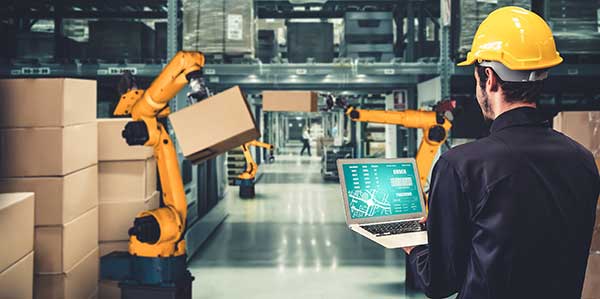AI is transforming engineering & construction — driving smarter projects, modern assets & redefining work while amplifying human expertise.
By Raghav K.A.
The engineering and construction industries are experiencing a pivotal shift. Long anchored in traditional methods and legacy systems, they are now embracing a new paradigm—one driven by the practical application of artificial intelligence. No longer confined to speculative future use, AI is being embedded in the very core of infrastructure development, asset modernization and project execution. From virtual assistants and agentic AI to digital twins and predictive maintenance, the technology is redefining how complex technical work is performed, while keeping human expertise front and center. This is further catalyzed by the host of platform providers, system integrators and model and framework developers, all coming together to build domain specific AI solutions for the engineering sector.

Industrial sectors such as construction, energy and infrastructure have historically lagged in digital transformation due to organization culture, extended lifecycle projects and deeply embedded legacy systems. Yet recent advances in cloud computing, data accessibility and scalable AI frameworks have cleared the path for meaningful adoption.
Leading engineering firms are not pursuing AI as a full-scale disruption. Instead, they’re deploying it strategically — augmenting human capabilities where it delivers the most value. AI now plays a vital role in reducing the burden of manual tasks, accelerating workflows, enabling the reuse of organizational knowledge and making complex systems more manageable.
A key turning point in this evolution has been the introduction of AI-powered assistants and agentic AI models designed to work seamlessly alongside engineers. These systems understand technical queries, navigate engineering databases and surface insights in seconds—amplifying productivity and freeing up time for higher-order thinking.
Unlike generic chatbots, AI-powered engineering assistants are deeply embedded into organizational systems. They’re trained in domain-specific knowledge of design standards, regulatory documents and historical project data, and equipped with natural language processing to engage with engineers in intuitive ways. These tools can resolve complex queries regarding design tolerances, material specifications or code compliance within minutes, improving decision-making across teams.
Going further, agentic AI systems are capable of taking autonomous actions within guardrails. For instance, they can proactively flag inconsistencies in design documents, suggest reuse of proven design templates or recommend project optimizations based on previous outcomes. These intelligent agents are rapidly becoming an indispensable layer in large-scale engineering project management.
Crucially, these solutions don’t require organizations to replace existing systems. Modular integration ensures they work with enterprise resource planning (ERP) systems, document management platforms and simulation tools—maximizing return on investment while minimizing disruption.
One of the most impactful use cases of AI is in the modernization of brownfield assets—aging infrastructure such as factories, refineries or transport systems. These assets often suffer from incomplete documentation, degraded performance and rising maintenance costs. Traditional approaches to modernization are slow, labor-intensive and costly.
Enter photogrammetry and lasergrammetry, paired with AI. These technologies scan physical assets in high resolution to produce digital 3D representations. AI then converts this data into digital twins—dynamic, intelligent replicas that simulate asset behavior in real time.
These digital twins do more than visualize structure. They enable predictive maintenance by forecasting component failures, suggest optimal operating conditions and support scenario analysis for retrofitting or expansion. In one recent case, digital twin implementation reduced unplanned downtime by over 20 percent and extended the asset’s lifespan by several years—without requiring a full overhaul.
AI also enables anomaly detection across these models by comparing real-world sensor data with expected performance baselines. This ability to spot deviations early and at scale is revolutionizing how brownfield assets are monitored and maintained. Digital twins can also improve the operational efficiency of the critical assets by continuously monitoring its performance “as designed” versus “as operated.”
Modern infrastructure projects involve a multitude of players—engineers, regulators, contractors, suppliers—all working across geographies and disciplines. This complexity often leads to coordination challenges, delays and budget overruns.
AI is becoming a powerful ally in managing this complexity. Machine learning algorithms trained on historical project data can identify risks such as material shortages, cost overruns or compliance issues. Natural language processing can parse regulatory codes and highlight areas of concern before formal audits. AI’s pattern recognition capabilities allow teams to anticipate issues and take corrective actions before they escalate.
AI agents can play an important role in monitoring the projects continuously against “as planned” versus “as executed,” identifying the risks and managing the risks on schedule, cost and quality. Agents can also predict the risks and can be better managed.
In design reviews and stakeholder meetings, AI systems now assist with real-time simulations—modeling how design changes impact cost, safety and timelines. This accelerates consensus-building and minimizes costly rework later in the project lifecycle.
As AI becomes deeply embedded in infrastructure workflows, responsible AI frameworks are critical. Industrial applications operate in high-stakes environments such as bridges, factories and power grids, where human lives, environmental safety and billions in assets may be at stake.
Progressive firms are building AI systems with clear explainability, human-in-the-loop controls and rigorous audit trails. These measures ensure that while AI handles complexity and volume, final accountability remains with qualified professionals. From safety compliance to bias mitigation in predictive models, responsible AI helps sustain stakeholder trust and regulatory approval.
Data governance also plays a vital role. Given that infrastructure projects often involve sensitive schematics and operational data, security and confidentiality are baked into AI systems through encryption, access control and policy-driven data usage.
Despite growing autonomy in AI systems, their purpose is not to replace engineers but to elevate them. AI takes on repetitive and data-heavy tasks, allowing engineers to focus on problem-solving, innovation and strategic planning. Human expertise remains central, especially where safety, ethics and engineering judgment are involved.
In sectors facing a knowledge gap due to an aging workforce, AI also helps capture and transfer institutional knowledge. By learning from past projects, AI can onboard junior engineers faster, recommend best practices and ensure continuity across generations of practitioners.
AI is reshaping engineering roles, necessitating new competencies in data science, machine learning and digital collaboration. Organizations are investing in AI literacy programs, mentorship models and continuous learning platforms to bridge the skills gap. This ensures that engineers remain central to innovation and strategic planning.
The next wave of AI in infrastructure may involve drone-based inspections powered by AI vision, generative AI models for automated design prototyping or adaptive systems that respond to climate risks in real time. AI models will expedite digital transformation in the infrastructure segment by bringing various aspects of building management systems, MEP (mechanical electrical plumping), safety and security, sustainable solutions, human centric design, waste management solutions, building information management, health and wellness systems and facility and operations management together on one platform.
Despite its potential, AI adoption faces hurdles such as data silos, workforce resistance and integration complexity. This needs to be addressed through phased rollouts, robust change management programs and targeted upskilling initiatives
But even as the technology evolves, the underlying principle must remain constant: AI should empower people, not displace them. The firms leading this charge are not those chasing flashy demos, but those investing in practical, ethical and human-centered AI.
In summary, AI is not a speculative future. It is a present reality delivering measurable gains in efficiency, sustainability and resilience. By addressing implementation challenges, tailoring solutions to sector needs and fostering human-AI synergy, the engineering and construction industries can unlock the full potential of AI. The guiding principle remains clear: AI should empower professionals, not replace them.

About the Author:
Raghav K.A. is SVP and Global Head of Engineering, Blockchain & Sustainability Services at Infosys, a global leader in next-generation digital services and consulting. At Infosys, Raghav is responsible for overseeing and growing client engagements in core product development, next generation engineering technologies including digital thread, generative design and AI / Generative AI across all industry verticals. He is an advisor to CTOs and CDOs in defining and implementing product strategy and digital transformation initiatives across the product value stream.
Read more from the author:
Compliance in the Age of AI | Information Week, March 13, 2025
In this episode, I sat down with Beejan Giga, Director | Partner and Caleb Emerson, Senior Results Manager at Carpedia International. We discussed the insights behind their recent Industry Today article, “Thinking Three Moves Ahead” and together we explored how manufacturers can plan more strategically, align with their suppliers, and build the operational discipline needed to support intentional, sustainable growth. It was a conversation packed with practical perspectives on navigating a fast-changing industry landscape.